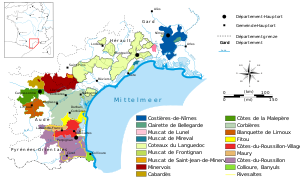Fitou (wine)
The Fitou wine-growing region is located in the Languedoc wine-growing region in the south of France . Fitou is an enclave within the Corbières area . The appellation has had the status of an Appellation d'Origine Contrôlée (AOC for short) since April 28, 1948 and covers around 2,600 hectares of vineyards. This makes the AOC Fitou the oldest AOC in Languedoc. The vineyards are located on the Mediterranean coast and border in the south on the appellation Côtes du Roussillon-Villages , which already belongs to the Roussillon wine-growing region .
The winemakers have the right to also press the wines of the Rivesaltes and Muscat de Rivesaltes appellations . Around 600 winegrowers produce almost 100,000 hectoliters of red wine every year. The majority of these winegrowers are affiliated with one of the five winegrowers' cooperatives , which market almost 85% of the total market. The remaining 15% is produced and sold by 31 private wineries. Only red wines are produced under the Fitou appellation that have to spend at least nine months in large wooden barrels or in small barriques .
After the appellation was very successful in the 1980s, sales from the early 1990s suffered from excessively high prices and deteriorating quality. A return to the concept of quality with strict harvest restrictions at the same time have given the appellation a secure livelihood again since the 2000s.
The appellation is geographically divided, it consists of two zones:
- Fitou Maritime with the municipalities of Caves , Fitou , La Palme , Leucate and Treilles . This zone is located between the A9 motorway and the Mediterranean coastline. The soil is loamy-chalky and heavily interspersed with pebbles.
- Fitou de Hautes-Corbières with the municipalities of Cascastel-des-Corbières , Durban-Corbières , Tuchan and Villeneuve-les-Corbières is about ten kilometers further inland. A slate floor predominates there.
Summer festival of the winemakers
To promote the community spirit of the inhabitants in the growing area and the sale of wine to tourists, a summer festival of the winegrowers has been held since 1993 at the beginning of August (“La fête vigneronne d'été”). It is organized alternately by one of the communities in the Fitou cultivation area and is linked to an open day for all winegrowers. During the festival, in addition to a producer market for local food and a small fair with rides, separate music events for young people and older people are organized in the evening. The brotherhoods of the participating towns and neighboring wine-growing regions also organize a small parade in sumptuous traditional costumes and then honor deserving winemakers in a festive ceremony.
Grape varieties
In general, an upper yield limit of 45 hectoliters / hectare applies in the Fitou wine-growing region. However, the 10-year average is 40 hectoliters / hectare.
The main grape varieties are Carignan (at least 30%), Grenache , Syrah and Mourvèdre . In addition, Cinsault and Lledoner Pelut are permitted to a lesser extent .
The combined share of Carignan, Grenache and Lledoner Pelut is at least 70%. Cinsault's share used to be at least 10%. However, it has not been approved since the 2008 harvest.
Since 2001, no new plantings of the Lledoner Pelut have been permitted, so that its share in the blends will naturally decrease in the next few years.
The minimum alcohol content of the red wine is 12.0% by volume.
literature
- Jancis Robinson : The Oxford Wine Lexicon . 2nd Edition. Hallwag , Munich 2003, ISBN 3-7742-0914-6 (886 pages, English: The Oxford companion to wine . Translated by Wolfgang Kissel).
- Pierre Galet: Cépages et Vignobles de France . Lavoisier Publishing House, Paris 2004, ISBN 2-7430-0585-8 .
- Benoît France: Grand Atlas des Vignobles de France . Éditions SOLAR publishing house, Paris 2002, ISBN 2-263-03242-8 .






